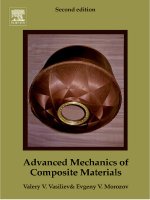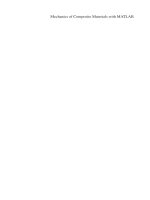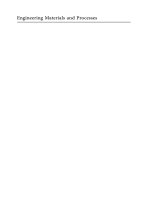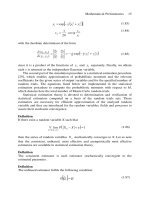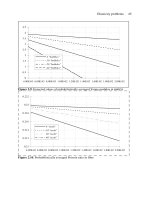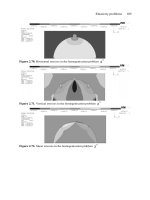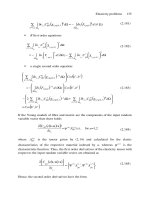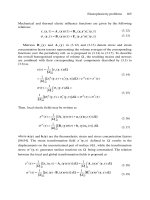ADVANCED MECHANICS OF COMPOSITE MATERIALS Episode 1 ppt
Bạn đang xem bản rút gọn của tài liệu. Xem và tải ngay bản đầy đủ của tài liệu tại đây (2.69 MB, 35 trang )
ADVANCED MECHANICS OF COMPOSITE MATERIALS
ADVANCED MECHANICS OF
COMPOSITE MATERIALS
Valery V. Vasiliev
Distinguished Professor
Department of Mechanics and Optimization of
Processes and Structures
Russian State University of Technology, Moscow
Evgeny V. Morozov
Professor of Mechanical Engineering
Division of Engineering Science & Technology
The University of New South Wales Asia, Singapore
Amsterdam • Boston • Heidelberg • London • New York • Oxford
Paris • San Diego • San Francisco • Singapore • Sydney • Tokyo
Elsevier
The Boulevard, Langford Lane, Kidlington, Oxford OX5 1GB, UK
Radarweg 29, PO Box 211, 1000 AE Amsterdam, The Netherlands
First edition 2007
Copyright © 2007 Elsevier Ltd. All rights reserved
No part of this publication may be reproduced, stored in a retrieval system
or transmitted in any form or by any means electronic, mechanical, photocopying,
recording or otherwise without the prior written permission of the publisher
Permissions may be sought directly from Elsevier’s Science & Technology Rights
Department in Oxford, UK: phone (+44) (0) 1865 843830; fax (+44) (0) 1865 853333;
email: Alternatively you can submit your request online by
visiting the Elsevier web site at and selecting
Obtaining permission to use Elsevier material
Notice
No responsibility is assumed by the publisher for any injury and/or damage to persons
or property as a matter of products liability, negligence or otherwise, or from any use
or operation of any methods, products, instructions or ideas contained in the material
herein. Because of rapid advances in the medical sciences, in particular, independent
verification of diagnoses and drug dosages should be made
British Library Cataloguing in Publication Data
A catalogue record for this book is available from the British Library
Library of Congress Cataloging-in-Publication Data
A catalog record for this book is available from the Library of Congress
ISBN: 978-0-08-045372-9
For information on all Elsevier publications
visit our web site at books.elsevier.com
Printed and bound in Great Britain
07080910 10987654321
PREFACE TO THE SECOND EDITION
This book is concerned with the topical problems of mechanics of advanced composite
materials whose mechanical properties are controlled by high-strength and high-stiffness
continuous fibers embedded in polymeric, metal, or ceramic matrix. Although the idea of
combining two or more components to produce materials with controlled properties has
been known and used from time immemorial, modern composites have been developed
only several decades ago and have found by now intensive applications in different fields
of engineering, particularly, in aerospace structures for which high strength-to-weight and
stiffness-to-weight ratios are required.
Due to wide existing and potential applications, composite technology has been devel-
oped very intensively over recent decades, and there exist numerous publications that
cover anisotropic elasticity, mechanics of composite materials, design, analysis, fabrica-
tion, and application of composite structures. According to the list of books on composites
presented in ‘Mechanics of Fibrous Composites’ by C.T. Herakovich (1998) there were
35 books published in this field before 1995, and this list should be supplemented now
with several new books.
In connection with this, the authors were challenged with a natural question as to what
caused the necessity to publish another book and what is the difference between this
book and the existing ones. Concerning this question, we had at least three motivations
supporting us in this work.
First, this book is of a more specific nature than the published ones which usually cover
not only mechanics of materials but also include analysis of composite beams, plates and
shells, joints, and elements of design of composite structures that, being also important, do
not strictly belong to the field of mechanics of composite materials. This situation looked
quite natural since composite science and technology, having been under intensive devel-
opment only over several past decades, required books of a universal type. Nowadays
however, implementation of composite materials has reached the level at which special
books can be dedicated to each of the aforementioned problems of composite technology
and, first of all, to mechanics of composite materials which is discussed in this book
in conjunction with analysis of composite materials. As we hope, thus constructed com-
bination of material science and mechanics of solids enabled us to cover such specific
features of material behavior as nonlinear elasticity, plasticity, creep, structural nonlin-
earity and discuss in details the problems of material micro- and macromechanics that
are only slightly touched in the existing books, e.g., stress diffusion in a unidirectional
material with broken fibers, physical and statistical aspects of fiber strength, coupling
effects in anisotropic and laminated materials, etc.
Second, this book, being devoted to materials, is written by designers of composite
structures who over the last 35 years were involved in practically all main Soviet and
v
vi Preface to the second edition
then Russian projects in composite technology. This governs the list of problems covered
in the book which can be referred to as material problems challenging designers and
determines the third of its specific features – discussion is illustrated with composite parts
and structures designed and built within the frameworks of these projects. In connection
with this, the authors appreciate the permission of the Russian Composite Center – Central
Institute of Special Machinery (CRISM) to use in the book the pictures of structures
developed and fabricated at CRISM as part of the joint research and design projects.
The primary aim of the book is the combined coverage of mechanics, technology,
and analysis of composite materials at the advanced level. Such an approach enables the
engineer to take into account the essential mechanical properties of the material itself
and special features of practical implementation, including manufacturing technology,
experimental results, and design characteristics.
The book consists of eight chapters progressively covering all structural levels of
composite materials from their components through elementary plies and layers to
laminates.
Chapter 1 is an introduction in which typical reinforcing and matrix materials as well
as typical manufacturing processes used in composite technology are described.
Chapter 2 is also a sort of introduction but dealing with fundamentals of mechanics of
solids, i.e., stress, strain, and constitutive theories, governing equations, and principles
that are used in the next chapters for analysis of composite materials.
Chapter 3 is devoted to the basic structural element of a composite material – unidirec-
tional composite ply. In addition to conventional description of micromechanical models
and experimental results, the physical nature of fiber strength, its statistical characteris-
tics, and interaction of damaged fibers through the matrix are discussed, and an attempt
is made to show that fibrous composites comprise a special class of man-made materials
utilizing natural potentials of material strength and structure.
Chapter 4 contains a description of typical composite layers made of unidirectional,
fabric, and spatially reinforced composite materials. Conventional linear elastic mod-
els are supplemented in this chapter with nonlinear elastic and elastic–plastic analysis
demonstrating specific types of behavior of composites with metal and thermoplastic
matrices.
Chapter 5 is concerned with mechanics of laminates and includes conventional descrip-
tion of the laminate stiffness matrix, coupling effects in typical laminates and procedures
of stress calculation for in-plane and interlaminar stresses.
Chapter 6 presents a practical approach to evaluation of laminate strength. Three main
types of failure criteria, i.e., structural criteria indicating the modes of failure, approx-
imation polynomial criteria treated as formal approximations of experimental data, and
tensor-polynomial criteria are discussed and compared with available experimental results
for unidirectional and fabric composites.
Chapter 7 dealing with environmental and special loading effects includes analysis
of thermal conductivity, hydrothermal elasticity, material aging, creep, and durability
under long-term loading, fatigue, damping, and impact resistance of typical advanced
composites. The effect of manufacturing factors on material properties and behavior
is demonstrated for filament winding accompanied with nonuniform stress distribution
Preface to the second edition vii
between the fibers and ply waviness and laying-up processing of nonsymmetric laminate
exhibiting warping after curing and cooling.
Chapter 8 covers a specific problem of material optimal design for composite materials
and presents composite laminates of uniform strength providing high weight efficiency of
composite structures demonstrated for filament-wound pressure vessels, spinning disks,
and anisogrid lattice structures.
This second edition is a revised, updated, and extended version of the first edition,
with new sections on: composites with high fiber fraction (Section 3.6), composites with
controlled cracks (Section 4.4.4), symmetric laminates (Section 5.4), engineering stiffness
coefficients of orthotropic laminates (Section 5.5), tensor strength criteria (Section 6.1.3),
practical recommendations (Section 6.2), allowable stresses for laminates consisting of
unidirectional plies (Section 6.4), hygrothermal effects and aging (Section 7.2), application
to optimal composite structures (Section 8.3), spinning composite disks (Section 8.3.2),
and anisogrid composite lattice structures (Section 8.3.3).
The following sections have been re-written and extended: Section 5.8 Antisymmet-
ric laminates; Section 7.3.3 Cyclic loading; Section 7.3.4 Impact loading; Section 8.3.1
Composite pressure vessels. More than 40 new illustrations and 5 new tables were added.
The new title ‘Advanced Mechanics of Composite Materials’ has been adopted for the
2nd edition, which provides better reflection of the overall contents and improvements,
extensions and revisions introduced in the present version.
The book offers a comprehensive coverage of the topic in full range: from basics
and fundamentals to the advanced modeling and analysis including practical design and
engineering applications and can be used as an up-to-date introductory text book aimed at
senior undergraduates and graduate students. At the same time it includes a detailed and
comprehensive coverage of the contemporary theoretical models at the micro- and macro-
levels of material structure, practical methods and approaches, experimental results, and
optimization of composite material properties and component performance that can be
used by researchers and engineers.
The authors would like to thank several people for their time and effort in making the
book a reality. Specifically, we would like to thank our Elsevier editors who have encour-
aged and participated in the preparation of the first and second editions. These include
Ian Salusbury (Publishing editor of the first edition), Emma Hurst and David Sleeman
(Publishing editors of the second edition), and Derek Coleman (Development editor).
Special thanks are due to Prof. Leslie Henshall, for his work on the text improvements
and to Dr. Konstantin Morozov for his help in the development of illustrations in the book.
The authors are also grateful to the Central Institute of Special Machinery (CRISM) that
supplied many illustrations and case studies.
Valery V. Vasiliev Evgeny V. Morozov
CONTENTS
Preface to the Second Edition v
Chapter 1. Introduction 1
1.1. Structural Materials 1
1.2. Composite Materials 9
1.2.1. Fibers for Advanced Composites 10
1.2.2. Matrix Materials 16
1.2.3. Processing 22
1.3. References 30
Chapter 2. Fundamentals of Mechanics of Solids 31
2.1. Stresses 31
2.2. Equilibrium Equations 33
2.3. Stress Transformation 35
2.4. Principal Stresses 36
2.5. Displacements and Strains 38
2.6. Transformation of Small Strains 41
2.7. Compatibility Equations 42
2.8. Admissible Static and Kinematic Fields 43
2.9. Constitutive Equations for an Elastic Solid 44
2.10. Formulations of the Problem 51
2.11. Variational Principles 52
2.11.1. Principle of Minimum Total Potential Energy 53
2.11.2. Principle of Minimum Strain Energy 54
2.11.3. Mixed Variational Principles 55
2.12. Reference 56
Chapter 3. Mechanics of a Unidirectional Ply 57
3.1. Ply Architecture 57
3.2. Fiber–Matrix Interaction 61
3.2.1. Theoretical and Actual Strength 61
3.2.2. Statistical Aspects of Fiber Strength 66
ix
x Contents
3.2.3. Stress Diffusion in Fibers Interacting through the Matrix 70
3.2.4. Fracture Toughness 83
3.3. Micromechanics of a Ply 86
3.4. Mechanical Properties of a Ply under Tension, Shear,
and Compression 101
3.4.1. Longitudinal Tension 102
3.4.2. Transverse Tension 106
3.4.3. In-Plane Shear 110
3.4.4. Longitudinal Compression 113
3.4.5. Transverse Compression 122
3.5. Hybrid Composites 123
3.6. Composites with High Fiber Fraction 127
3.7. Phenomenological Homogeneous Model of a Ply 129
3.8. References 131
Chapter 4. Mechanics of a Composite Layer 133
4.1. Isotropic Layer 133
4.1.1. Linear Elastic Model 133
4.1.2. Nonlinear Models 137
4.2. Unidirectional Orthotropic Layer 154
4.2.1. Linear Elastic Model 154
4.2.2. Nonlinear Models 157
4.3. Unidirectional Anisotropic Layer 162
4.3.1. Linear Elastic Model 162
4.3.2. Nonlinear Models 182
4.4. Orthogonally Reinforced Orthotropic Layer 183
4.4.1. Linear Elastic Model 184
4.4.2. Nonlinear Models 187
4.4.3. Two-Matrix Composites 201
4.4.4. Composites with Controlled Cracks 207
4.5. Angle-Ply Orthotropic Layer 208
4.5.1. Linear Elastic Model 209
4.5.2. Nonlinear Models 215
4.5.3. Free-Edge Effects 227
4.6. Fabric Layers 233
4.7. Lattice Layer 241
4.8. Spatially Reinforced Layers and Bulk Materials 243
4.9. References 253
Chapter 5. Mechanics of Laminates 255
5.1. Stiffness Coefficients of a Generalized Anisotropic Layer 255
5.2. Stiffness Coefficients of a Homogeneous Layer 267
5.3. Stiffness Coefficients of a Laminate 269
Contents xi
5.4. Symmetric Laminates 271
5.5. Engineering Stiffness Coefficients of Orthotropic Laminates 273
5.6. Quasi-Homogeneous Laminates 287
5.6.1. Laminate Composed of Identical Homogeneous Layers 287
5.6.2. Laminate Composed of Inhomogeneous Orthotropic Layers 287
5.6.3. Laminate Composed of Angle-Ply Layers 289
5.7. Quasi-Isotropic Laminates 290
5.8. Antisymmetric Laminates 293
5.9. Sandwich Structures 299
5.10. Coordinate of the Reference Plane 300
5.11. Stresses in Laminates 304
5.12. Example 306
5.13. References 320
Chapter 6. Failure Criteria and Strength of Laminates 321
6.1. Failure Criteria for an Elementary Composite Layer or Ply 321
6.1.1. Maximum Stress and Strain Criteria 323
6.1.2. Approximation Strength Criteria 331
6.1.3. Tensor Strength Criteria 335
6.1.4. Interlaminar Strength 343
6.2. Practical Recommendations 345
6.3. Examples 345
6.4. Allowable Stresses for Laminates Consisting of
Unidirectional Plies 351
6.5. References 357
Chapter 7. Environmental, Special Loading, and Manufacturing
Effects 359
7.1. Temperature Effects 359
7.1.1. Thermal Conductivity 360
7.1.2. Thermoelasticity 365
7.2. Hygrothermal Effects and Aging 377
7.3. Time and Time-Dependent Loading Effects 385
7.3.1. Viscoelastisity 385
7.3.2. Durability 399
7.3.3. Cyclic Loading 400
7.3.4. Impact Loading 408
7.4. Manufacturing Effects 419
7.4.1. Circumferential Winding and Tape Overlap Effect 420
7.4.2. Warping and Bending of Laminates in Fabrication Process 426
7.4.3. Shrinkage Effects and Residual Strains 430
7.5. References 433
xii Contents
Chapter 8. Optimal Composite Structures 437
8.1. Optimal Fibrous Structures 437
8.2. Composite Laminates of Uniform Strength 445
8.3. Application to Optimal Composite Structures 451
8.3.1. Composite Pressure Vessels 451
8.3.2. Spinning Composite Disks 465
8.3.3. Anisogrid Composite Lattice Structures 470
8.4. References 480
Author Index 481
Subject Index 485
Chapter 1
INTRODUCTION
1.1. Structural materials
Materials are the basic elements of all natural and man-made structures. Figuratively
speaking, these materialize the structural conception. Technological progress is associated
with continuous improvement of existing material properties as well as with the expansion
of structural material classes and types. Usually, new materials emerge due to the necessity
to improve structural efficiency and performance. In addition, new materials themselves
as a rule, in turn provide new opportunities to develop updated structures and technology,
while the latter challenges materials science with new problems and tasks. One of the best
manifestations of this interrelated process in the development of materials, structures, and
technology is associated with composite materials, to which this book is devoted.
Structural materials possess a great number of physical, chemical and other types of
properties, but at least two principal characteristics are of primary importance. These
characteristics are the stiffness and strength that provide the structure with the ability to
maintain its shape and dimensions under loading or any other external action.
High stiffness means that material exhibits low deformation under loading. However, by
saying that stiffness is an important property we do not mean that it should be necessarily
high. The ability of a structure to have controlled deformation (compliance) can also
be important for some applications (e.g., springs; shock absorbers; pressure, force, and
displacement gauges).
Lack of material strength causes an uncontrolled compliance, i.e., in failure after which
a structure does not exist any more. Usually, we need to have as high strength as possible,
but there are some exceptions (e.g., controlled failure of explosive bolts is used to separate
rocket stages).
Thus, without controlled stiffness and strength the structure cannot exist. Naturally, both
properties depend greatly on the structure’s design but are determined by the stiffness and
strength of the structural material because a good design is only a proper utilization of
material properties.
To evaluate material stiffness and strength, consider the simplest test – a bar with cross-
sectional area A loaded with tensile force F as shown in Fig. 1.1. Obviously, the higher the
force causing the bar rupture, the higher is the bar’s strength. However, this strength does
not only depend on the material properties – it is proportional to the cross-sectional area A.
1
2 Advanced mechanics of composite materials
A
F
F
L
0
∆
Fig. 1.1. A bar under tension.
Thus, it is natural to characterize material strength by the ultimate stress
σ =
F
A
(1.1)
where
F is the force causing the bar failure (here and subsequently we use the overbar
notation to indicate the ultimate characteristics). As follows from Eq. (1.1), stress is
measured as force divided by area, i.e., according to international (SI) units, in pascals
(Pa) so that 1 Pa =1 N/m
2
. Because the loading of real structures induces relatively high
stresses, we also use kilopascals (1 kPa = 10
3
Pa), megapascals (1 MPa = 10
6
Pa), and
gigapascals (1 GPa = 10
9
Pa). Conversion of old metric (kilogram per square centimeter)
and English (pound per square inch) units to pascals can be done using the following
relations: 1 kg/cm
2
= 98 kPa and 1 psi = 6.89 kPa.
For some special (e.g., aerospace or marine) applications, i.e., for which material
density, ρ, is also important, a normalized characteristic
k
σ
=
σ
ρ
(1.2)
is also used to describe the material. This characteristic is called the ‘specific strength’
of a material. If we use old metric units, i.e., measure force and mass in kilograms and
dimensions in meters, substitution of Eq. (1.1) into Eq. (1.2) yields k
σ
in meters. This
result has a simple physical sense, namely k
σ
is the length of the vertically hanging fiber
under which the fiber will be broken by its own weight.
The stiffness of the bar shown in Fig. 1.1 can be characterized by an elongation cor-
responding to the applied force F or acting stress σ = F/A. However, is proportional
to the bar’s length L
0
. To evaluate material stiffness, we introduce strain
ε =
L
0
(1.3)
Since ε is very small for structural materials the ratio in Eq. (1.3) is normally multiplied
by 100, and ε is expressed as a percentage.
Chapter 1. Introduction 3
Naturally, for any material, there should be some interrelation between stress and
strain, i.e.,
ε = f(σ) or σ = ϕ(ε) (1.4)
These equations specify the so-called constitutive law and are referred to as constitutive
equations. They allow us to introduce an important concept of the material model which
represents some idealized object possessing only those features of the real material that are
essential for the problem under study. The point is that in performing design or analysis
we always operate with models rather than with real materials. Particularly, for strength
and stiffness analysis, such a model is described by constitutive equations, Eqs. (1.4), and
is specified by the form of the function f(σ) or ϕ(ε).
The simplest is the elastic model which implies that f(0) = 0,ϕ(0) = 0 and that
Eqs. (1.4) are the same for the processes of an active loading and an unloading. The
corresponding stress–strain diagram (or curve) is presented in Fig. 1.2. The elastic model
(or elastic material) is characterized by two important features. First, the corresponding
constitutive equations, Eqs. (1.4), do not include time as a parameter. This means that the
form of the curve shown in Fig. 1.2 does not depend on the rate of loading (naturally, it
should be low enough to neglect inertial and dynamic effects). Second, the active loading
and the unloading follow one and the same stress–strain curve as in Fig. 1.2. The work
performed by force F in Fig. 1.1 is accumulated in the bar as potential energy, which is also
referred to as strain energy or elastic energy. Consider some infinitesimal elongation d
and calculate the elementary work performed by the force F in Fig. 1.1 as dW = F d.
Then, work corresponding to point 1 of the curve in Fig. 1.2 is
W =
1
0
F d
1
0
e
s
Fig. 1.2. Stress–strain curve for an elastic material.
4 Advanced mechanics of composite materials
where
1
is the elongation of the bar corresponding to point 1 of the curve. The work W
is equal to elastic energy of the bar which is proportional to the bar’s volume and can be
presented as
E = L
0
A
ε
1
0
σ dε
where σ = F/A, ε = /L
0
, and ε
1
=
1
/L
0
. Integral
U =
ε
1
0
σ dε =
ε
1
0
ϕ(ε)dε (1.5)
is a specific elastic energy (energy accumulated in a unit volume of the bar) that is referred
to as an elastic potential. It is important that U does not depend on the history of loading.
This means that irrespective of the way we reach point 1 of the curve in Fig. 1.2 (e.g., by
means of continuous loading, increasing force F step by step, or using any other loading
program), the final value of U will be the same and will depend only on the value of final
strain ε
1
for the given material.
A very important particular case of the elastic model is the linear elastic model described
by the well-known Hooke’s law (see Fig. 1.3)
σ = Eε (1.6)
Here, E is the modulus of elasticity. It follows from Eqs. (1.3) and (1.6), that E = σ
if ε = 1, i.e., if = L
0
. Thus, the modulus can be interpreted as the stress causing
elongation of the bar in Fig. 1.1 to be the same as the initial length. Since the majority of
structural materials fail before such a high elongation can occur, the modulus is usually
much higher than the ultimate stress
σ .
1
0
e
s
Fig. 1.3. Stress–strain diagram for a linear elastic material.
Chapter 1. Introduction 5
Similar to specific strength k
σ
in Eq. (1.2), we can introduce the corresponding specific
modulus
k
E
=
E
ρ
(1.7)
which describes a material’s stiffness with respect to its material density.
Absolute and specific values of mechanical characteristics for typical materials
discussed in this book are listed in Table 1.1.
After some generalization, the modulus can be used to describe nonlinear material
behavior of the type shown in Fig. 1.4. For this purpose, the so-called secant, E
s
, and
tangent, E
t
, moduli are introduced as
E
s
=
σ
ε
=
σ
f(σ)
E
t
=
dσ
dε
=
dϕ(ε)
dε
(1.8)
While the slope α in Fig. 1.4 determines the conventional modulus E, the slopes β
and γ determine E
s
and E
t
, respectively. As can be seen, E
s
and E
t
, in contrast to E,
depend on the level of loading, i.e., on σ or ε. For a linear elastic material (see Fig. 1.3),
E
s
= E
t
= E.
Hooke’s law, Eq. (1.6), describes rather well the initial part of stress–strain diagram
for the majority of structural materials. However, under a relatively high level of stress
or strain, materials exhibit nonlinear behavior.
One of the existing models is the nonlinear elastic material model introduced above
(see Fig. 1.2). This model allows us to describe the behavior of highly deformable rubber-
type materials.
Another model developed to describe metals is the so-called elastic–plastic material
model. The corresponding stress–strain diagram is shown in Fig. 1.5. In contrast to an
elastic material (see Fig. 1.2), the processes of active loading and unloading are described
with different laws in this case. In addition to elastic strain, ε
e
, which disappears after the
load is taken off, the residual strain (for the bar shown in Fig. 1.1, it is plastic strain, ε
p
)
remains in the material. As for an elastic material, the stress–strain curve in Fig. 1.5 does
not depend on the rate of loading (or time of loading). However, in contrast to an elastic
material, the final strain of an elastic–plastic material can depend on the history of loading,
i.e., on the law according to which the final value of stress was reached.
Thus, for elastic or elastic–plastic materials, constitutive equations, Eqs. (1.4), do not
include time. However, under relatively high temperature practically all the materials
demonstrate time-dependent behavior (some of them do it even under room temperature).
If we apply some force F to the bar shown in Fig. 1.1 and keep it constant, we can see that
for a time-sensitive material the strain increases under a constant force. This phenomenon
is called the creep of the material.
So, the most general material model that is used in this book can be described with a
constitutive equation of the following type:
ε = f(σ,t,T) (1.9)
6 Advanced mechanics of composite materials
Table 1.1
Mechanical properties of structural materials and fibers.
Material Ultimate
tensile
stress,
σ (MPa)
Modulus,
E (GPa)
Specific
gravity
Maximum
specific
strength,
k
σ
×10
3
(m)
Maximum
specific
modulus,
k
E
×10
3
(m)
Metal alloys
Steel 400–2200 180–210 7.8–7.85 28.8 2750
Aluminum 140–700 69–72 2.7–2.85 26.5 2670
Titanium 420–1200 110 4.5 26.7 2440
Magnesium 220–320 40 1.8 14.4 2220
Beryllium 620 320 1.85 33.5 17,300
Nickel 400–500 200 8.9 5.6 2250
Metal wires (diameter, µm)
Steel (20–1500) 1500–4400 180–200 7.8 56.4 2560
Aluminum (150) 290 69 2.7 10.7 2550
Titanium (100–800) 1400–1500 120 4.5 33.3 2670
Beryllium (50–500) 1100–1450 240–310 1.8–1.85 80.5 17,200
Tungsten (20–50) 3300–4000 410 19–19.3 21.1 2160
Molybdenum (25–250) 1800–2200 360 10.2 21.5 3500
Thermoset polymeric resins
Epoxy 60–90 2.4–4.2 1.2–1.3 7.5 350
Polyester 30–70 2.8–3.8 1.2–1.35 5.8 310
Phenol-formaldehyde 40–70 7–11 1.2–1.3 5.8 910
Organosilicone 25–50 6.8–10 1.35–1.4 3.7 740
Polyimide 55–110 3.2 1.3–1.43 8.5 240
Bismaleimide 80 4.2 1.2 6.7 350
Thermoplastic polymers
Polyethylene 20–45 6–8.5 0.95 4.7 890
Polystyrene 35–45 30 1.05 4.3 2860
Teflon 15–35 3.5 2.3 1.5 150
Nylon 80 2.8 1.14 7.0 240
Polyester (PC) 60 2.5 1.32 4.5 190
Polysulfone (PSU) 70 2.7 1.24 5.6 220
Polyamide-imide (PAI) 90–190 2.8–4.4 1.42 13.4 360
Polyetheretherketone (PEEK) 90–100 3.1–3.8 1.3 7.7 300
Polyphenylene sulfide (PPS) 80 3.5 1.36 5.9 250
Synthetic fibers
Capron 680–780 4.4 1.1 70 400
Dacron 390–880 4.9–15.7 1.4 60 1430
Teflon 340–440 2.9 2.3 190 130
Nitron 390–880 4.9–8.8 1.2 70 730
Polypropylene 730–930 4.4 0.9 100 480
Viscose 930 20 1.52 60 1300
Fibers for advanced composites (diameter, µm)
Glass (3–19) 3100–5000 72–95 2.4–2.6 200 3960
Quarts (10) 6000 74 2.2 270 3360
Chapter 1. Introduction 7
Table 1.1 (Contd.)
Material Ultimate
tensile
stress,
σ (MPa)
Modulus,
E (GPa)
Specific
gravity
Maximum
specific
strength,
k
σ
×10
3
(m)
Maximum
specific
modulus,
k
E
×10
3
(m)
Basalt (9–13) 3000–3500 90 2.7–3.0 130 3300
Aramid (12–15) 3500–5500 140–180 1.4–1.47 390 12,800
Polyethylene (20–40) 2600–3300 120–170 0.97 310 17,500
Carbon (5–11)
High-strength 7000 300 1.75 400 17,100
High-modulus 2700 850 1.78 150 47,700
Boron (100–200) 2500–3700 390–420 2.5–2.6 150 16,800
Alumina – Al
2
O
3
(20–500) 2400–4100 470–530 3.96 100 13,300
Silicon Carbide – SiC (10–15) 2700 185 2.4–2.7 110 7700
Titanium Carbide – TiC (280) 1500 450 4.9 30 9100
Boron Carbide – B
4
C (50) 2100–2500 480 2.5 100 10,000
Boron Nitride – BN (7) 1400 90 1.9 70 4700
d
s
de
a
b
e
e
g
s
s
Fig. 1.4. Introduction of secant and tangent moduli.
where t indicates the time moment, whereas σ and T are stress and temperature, corre-
sponding to this moment. In the general case, constitutive equation, Eq. (1.9), specifies
strain that can be decomposed into three constituents corresponding to elastic, plastic and
creep deformation, i.e.,
ε = ε
e
+ε
p
+ε
c
(1.10)
However, in application to particular problems, this model can be usually substantially
simplified. To show this, consider the bar in Fig. 1.1 and assume that a force F is applied
at the moment t = 0 and is taken off at moment t = t
1
as shown in Fig. 1.6a. At the
8 Advanced mechanics of composite materials
e
e
e
e
p
s
Fig. 1.5. Stress–strain diagram for elastic–plastic material.
e
c
(t)
F
tt
1
e
e
+ e
p
e
t
c
e
p
+ e
c
r
t
t
1
(a)
(b)
e
e
e
Fig. 1.6. Dependence of force (a) and strain (b) on time.
Chapter 1. Introduction 9
moment t = 0, elastic and plastic strains that do not depend on time appear, and while
time is running, the creep strain is developed. At the moment t = t
1
, the elastic strain
disappears, while the reversible part of the creep strain, ε
t
c
, disappears with time. Residual
strain consists of the plastic strain, ε
p
, and residual part of the creep strain, ε
r
c
.
Now assume that ε
p
ε
e
which means that either the material is elastic or the applied
load does not induce high stress and, hence, plastic strain. Then we can neglect ε
p
in
Eq. (1.10) and simplify the model. Furthermore, let ε
c
ε
e
which in turn means that
either the material is not susceptible to creep or the force acts for a short time (t
1
is close
to zero). Thus, we arrive at the simplest elastic model, which is the case for the majority of
practical applications. It is important that the proper choice of the material model depends
not only on the material nature and properties but also on the operational conditions of the
structure. For example, a shell-type structure made of aramid–epoxy composite material,
that is susceptible to creep, and designed to withstand the internal gas pressure should
be analyzed with due regard to the creep, if this structure is a pressure vessel for long
term gas storage. At the same time for a solid propellant rocket motor case working for
seconds, the creep strain can be ignored.
A very important feature of material models under consideration is their phenomeno-
logical nature. This means that these models ignore the actual material microstructure
(e.g., crystalline structure of metals or molecular structure of polymers) and represent the
material as some uniform continuum possessing some effective properties that are the
same irrespective of how small the material volume is. This allows us, first, to determine
material properties testing material samples (as in Fig. 1.1). Second, this formally enables
us to apply methods of Mechanics of Solids that deal with equations derived for infinitesi-
mal volumes of material. And third, this allows us to simplify the strength and stiffness
evaluation problem and to reduce it to a reasonable practical level not going into analysis
of the actual mechanisms of material deformation and fracture.
1.2. Composite materials
This book is devoted to composite materials that emerged in the middle of the
20th century as a promising class of engineering materials providing new prospects for
modern technology. Generally speaking any material consisting of two or more compo-
nents with different properties and distinct boundaries between the components can be
referred to as a composite material. Moreover, the idea of combining several components
to produce a material with properties that are not attainable with the individual compo-
nents has been used by man for thousands of years. Correspondingly, the majority of
natural materials that have emerged as a result of a prolonged evolution process can be
treated as composite materials.
With respect to the problems covered in this book we can classify existing composite
materials (composites) into two main groups.
The first group comprises composites that are known as ‘filled materials.’ The main
feature of these materials is the existence of some basic or matrix material whose properties
are improved by filling it with some particles. Usually the matrix volume fraction is more
than 50% in such materials, and material properties, being naturally modified by the
10 Advanced mechanics of composite materials
fillers, are governed mainly by the matrix. As a rule, filled materials can be treated as
homogeneous and isotropic, i.e., traditional models of mechanics of materials developed
for metals and other conventional materials can be used to describe their behavior. This
group of composites is not touched on in the book.
The second group of composite materials that is under study here involves composites
that are called ‘reinforced materials.’ The basic components of these materials (sometimes
referred to as ‘advanced composites’) are long and thin fibers possessing high strength
and stiffness. The fibers are bound with a matrix material whose volume fraction in a
composite is usually less than 50%. The main properties of advanced composites, due
to which these materials find a wide application in engineering, are governed by fibers
whose types and characteristics are considered below. The following sections provide a
concise description of typical matrix materials and fiber-matrix compositions. Two com-
ments should be made with respect to the data presented in these sections. First, only
brief information concerning material properties that are essential for the problems cov-
ered in this book is presented there, and, second, the given data are of a broad nature
and are not expected to be used in design or analysis of particular composite structures.
More complete description of composite materials and their components including the his-
tory of development and advancement, chemical compositions, physical characteristics,
manufacturing, and applications can be found elsewhere (Peters, 1998).
1.2.1. Fibers for advanced composites
Continuous glass fibers (the first type of fibers used in advanced composites) are made
by pulling molten glass (at a temperature about 1300
◦
C) through 0.8–3.0 mm diameter
dies and further high-speed stretching to a diameter of 3–19 µm. Usually glass fibers
have solid circular cross sections. However there exist fibers with rectangular (square
or plane), triangular, and hexagonal cross sections, as well as hollow circular fibers.
Typical mechanical characteristics and density of glass fibers are listed in Table 1.1,
whereas a typical stress–strain diagram is shown in Fig. 1.7.
Important properties of glass fibers as components of advanced composites for engi-
neering applications are their high strength, which is maintained in humid environments
but degrades under elevated temperatures (see Fig. 1.8), relatively low stiffness (about
40% of the stiffness of steel), high chemical and biological resistance, and low cost. Being
actually elements of monolithic glass, the fibers do not absorb water and do not change
their dimensions in water. For the same reason, they are brittle and sensitive to surface
damage.
Quartz fibers are similar to glass fibers and are obtained by high-speed stretching of
quartz rods made of (under temperature of about 2200
◦
C) fused quartz crystals or sand.
The original process developed for manufacturing glass fibers cannot be used because the
viscosity of molten quartz is too high to make thin fibers directly. However, this more
complicated process results in fibers with higher thermal resistance than glass fibers.
The same process that is used for glass fibers can be employed to manufacture mineral
fibers, e.g., basalt fibers made of molten basalt rocks. Having relatively low strength
and high density (see Table 1.1) basalt fibers are not used for high-performance, e.g.,
Chapter 1. Introduction 11
7
6
5
4
3
2
1
0123456
s, GPa
e, %
H-M Carbon
Boron
H-S Carbon
Steel
Aramid
Glass
Polyethylene
Fig. 1.7. Stress–strain diagrams for typical fibers of advanced composites.
aerospace structures, but are promising reinforcing elements for pre-stressed reinforced
concrete structures in civil engineering.
Substantial improvement of a fiber’s stiffness in comparison with glass fibers has been
achieved with the development of carbon (or graphite) fibers. Modern high-modulus car-
bon fibers have a modulus that is a factor of about four higher than the modulus of steel,
whereas the fiber density is lower by the same factor. Although the first carbon fibers had
lower strength than glass fibers, modern high-strength fibers have a 40% higher tensile
strength compared to the strength of the best glass fibers, whereas the density of carbon
fibers is 30% less than that of glass fibers.
Carbon fibers are made by pyrolysis of organic fibers of which there exist two main
types – PAN-based and pitch-based fibers. For PAN-based fibers the process consists of
